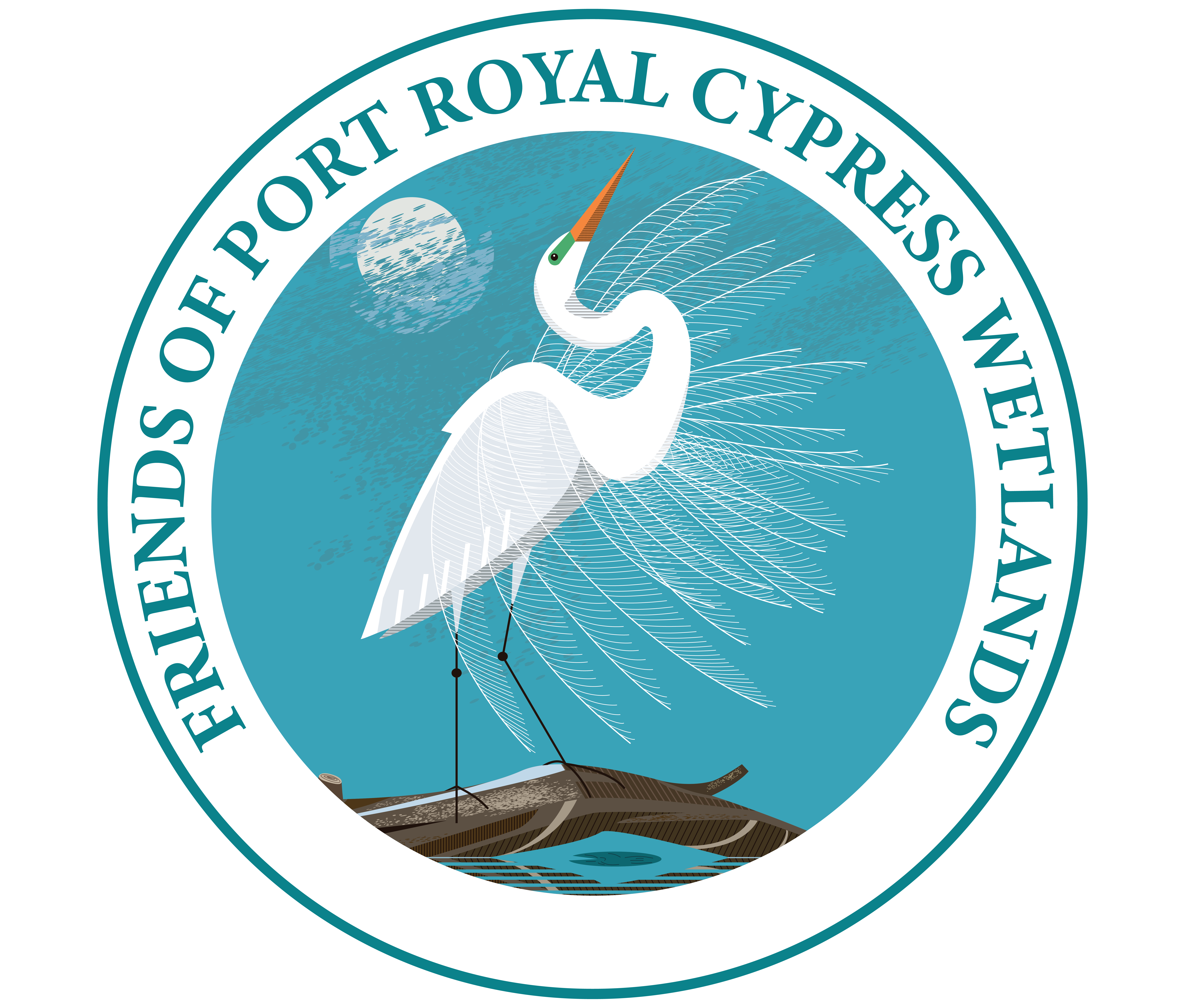What is a Rookery?
A rookery is a communal nesting ground for gregarious birds. While birds do not share individual nest duties, the collection of nests in a small area gives nesting birds and vulnerable chicks extra protection and advantages. Though individual nests are independent, there are benefits for birds to nest in colonial groups.
Wading Birds
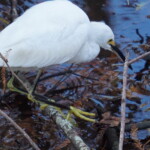
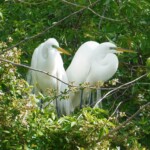

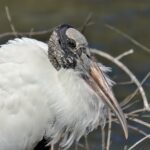
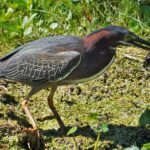

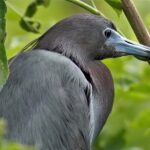
The most common nesting birds at Cypress Wetlands include great and snowy egrets, and little blue, green, tricolored, and black crested night herons. Little blue herons are all white like snowy egrets when they are young, but lose their white feathers and become slate blue as adults. White ibis, wood stork, roseate spoonbill, yellow crowned night heron, cattle egret, glossy ibis, green blue heron, and other birds also visit the rookery.
Nesting starts in early spring on islands, trees, and shrubs surrounded by water. Even though duckweed and mosquito fern can cover the water surface, the deep water holds many alligators. Having alligators patrolling the water protects the nesting birds, eggs, and hatchlings from raccoons, cats, opossums, rats, otters, and other land-based predators. Periodic clearing to maintain the open water is necessary to protect and sustain the bird rookery. The diverse trees, shrubs, and marsh grass in the wetlands provide different foraging and nesting habitats for many species.
Wading birds, especially the great and snowy egrets, suffered extreme threats from overhunting and loss of wetland habitat in the late 1800’s. Hunting for their feathers to decorate hats nearly devastated the egrets before 1918, when the Migratory Bird Treaty Act protected them.
Wrens and Woodpeckers
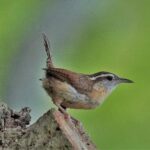

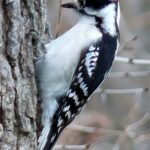
The path through the forest is an ideal place to see the state bird, the Carolina Wren. It hops along the ground and in low bushes, eating insects found in the undergrowth, as well as native berries.
The thicket of wax myrtle, willow and buttonbush protects nesting and foraging habitats for the path activity. The tangled and thorny vines protect small bird nests from predators such as feral cats, opossums, raccoons, and snakes. Keeping this thicket of “nature’s barbed-wire” intact and untrimmed helps vulnerable eggs, nestlings, and other baby wildlife survive.
The tall trees of the forest provide foraging and nesting habitat for some of the eight species of woodpeckers found in South Carolina. Woodpeckers are often heard before they are seen in these woods, as they drum on trees to announce courtship and territory claims. The small downy woodpecker and the yellow-bellied sapsucker are the most likely to be found in this area. The downy woodpecker feeds mostly on insects and grubs, by probing holes in trees and plants with its long, barbed tongue. The sapsucker, as its name implies, makes a series of holes in tree bark from which it laps up the sap. It migrates north in the summer and is seen in Port Royal during the winter.
Wetland Birds
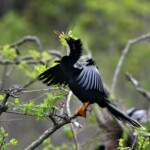
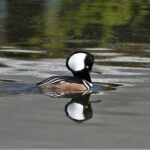

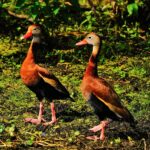
The wetland teems with birds who use the willow and buttonbush shrubs for twigs to build nests, and to hid and hunt for insects, snails, and aquatic animals. The anhinga, a black and brown bird with short legs, nests in the Cypress Wetlands with the egrets. They nest along with the colonial wading birds, sometimes taking over another bird’s nest.
Visitors often see osprey, turkey and black vultures, red tailed and red shouldered hawks, and boat-tailed grackle around the wetlands. Common birds include the red winged blackbird, which eat insects, seeds, grasses, weeds, small fruits and berries. They build nests on the marsh grass in March to May.
The common gallinule (also called a moorhen or marsh hen), a medium sized black bird with a red face, stealthily hunts at the water’s edge among the shrubs. It walks on floating vegetation and eats plants, snails, and insects.
Wetlands connect by local streams and rivers, as well as the bird populations that migrate thousands of miles across our continent. The wetlands and islands around Port Royal include globally recognized bird diversity, numbers, and wonders. In 2015, Audubon designated the Beaufort Barrier Islands as a Globally Important Bird Area (IBA). Over 182 species of birds use this IBA for habitat, including the woods stork that visit the Cypress Wetlands.
Birds Of Prey

Osprey
Usually seen at a high distance, the Osprey, with its crooked wings and whitish underparts, may look initially like a gull. Note, however, the dark wrist marks on the wings and its dark eye stripe to make the distinction. The osprey’s call is a high-pitched, pleading cheep, cheep, cheep or pleep, pleep, pleep.

Bald Eagle
In flight and at a distance, the national bird of the US can be identified by its white head and tail and massive broad wings that are held flat rather than raised, as is the case with the Turkey Vulture. Their voice is an unexpected thin kleek-kik-kik-kik.

Red Shouldered Hawk
The medium sized Red Shouldered Hawk with banded tail is frequently seen and heard in the Wetlands. It hunts from roadside perches such as telephone wires as well as high up in the tree branches. Its persistent screaming kyaah, kyaah, kyaah call often draws attention to it.

Red Tailed Hawk
The Red Tailed Hawk is highly variable in plumage. Most are dark above and pale below. Adults have an orange-red tail. When perched, a V-shaped mottling on the back is a good field mark. Their call is a downward-slurred scream: keeer-eee.
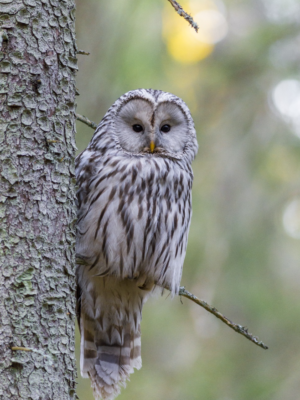
Barred Owl
The chunky brown eyed barred owl is a common visitor to the Cypress Wetlands. It has dark barring across its chest with dark vertical streaks on the rest of its underparts. The barred owl gives a varied series of barking hoots: “Who cooks for-you?” “Who cooks for you-all?” call. You may hear them in the late afternoon or at daylight.
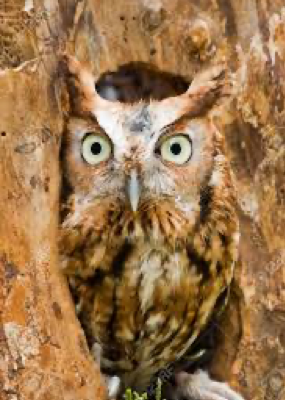
Eastern Screech Owl
The Eastern Screech Owl is a small owl with ear tufts. Their color is red in the southeast but will be seen as gray if you visit the Great Plains or southern Texas. They nest in holes in trees where you may find them sitting in morning or winter daylight. Their voice is a mournful whinny or wail with a descending pitch or a pulsing series of single pitches.
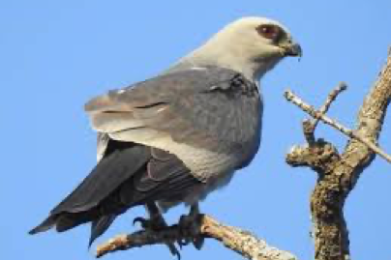
Mississippi Kite
The Wetlands is an ideal habitat for the Mississippi Kite; a long, soft gray bird with a black eye smudge. Its black tail flares at the tip. You’ll hear them voicing a phee-phew or kee-ee call.
Bird Species & Habitat
Key
C – Common / FC – Fairly Common / V – Visitor / PR – Permanent Resident / M – Migrant
W – Winter / S – Summer / SP – Spring / F – Fall
Lakes
- Pied-Billed Grebe (FC, WR)
- Anhinga (FC)
- Great Blue Heron (C, PR)
- Great Egret (C, PR)
- Snowy Egret (C, PR)
- Belted Kingfisher (C, PR)
- Green-Backed Heron (C, SP)
- Blue-Winged Teal (FC)
- Green-Winged Teal (FC)
- Bufflehead (FC)
- Hooded Merganser (FC WV)
Marshes
- Tri-Colored Heron (FC, WS)
- Red-Wing Black Bird (C)
- Common Grackle (C, PR)
- Boat-Tailed Grackle (C, PR)
Woodland & Scrub
- Barred Owl (FC)
- Morning Dove (FC, PR)
- Rudy Throated Hummingbird (C, SP)
- Common Flicker (C, PR)
- Yellow-Bellied Sapsucker (FC)
- Downy Woodpecker (C)
- Great Crested Flycatcher (C, SP)
- Blue Jay (C, PR)
- Common Crow (C, PR)
- Fish Crow (C, PR)
- Carolina Chickadee (C, PR)
- Carolina Wren (C, PR)
- Mockingbird (C, PR)
- Grey Catbird (FC, SP)
- Brown Thrasher (FC)
- Blue-Grey Gnatcatcher (C, S)
- Cedar Waxwing (C, WM)
- Yellow-Throated Warbler (C, WV)
- Pine Warbler (FC, PR)
- Palm Warbler (FC, WV)
- Brown Headed Cowbird (C, SV)
- Cardinal (C, PR)
- American Goldfinch (C, WV)
- Tufted Titmouse (C, W)
- White-eyed Vireo (FC SP)
- Chipping Sparrow (FC, W)
- Red Shouldered Hawk (C, PR)
Follow us
